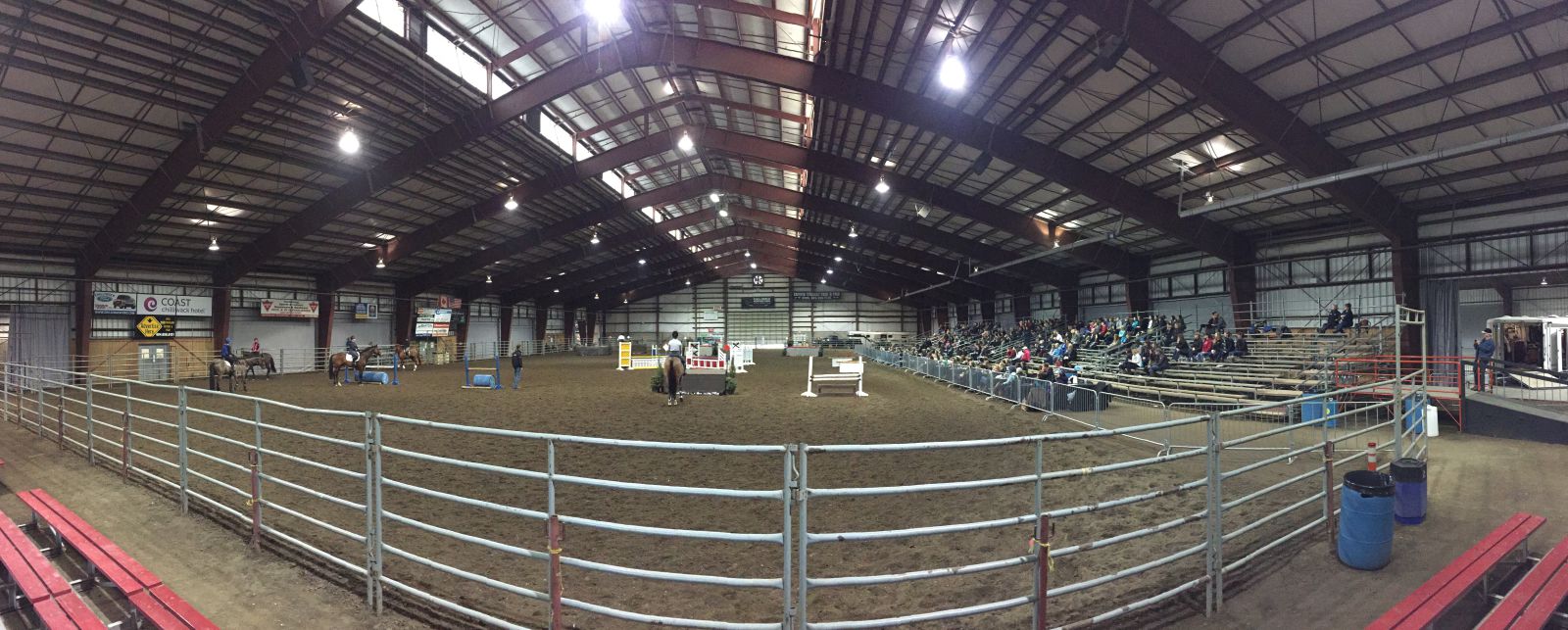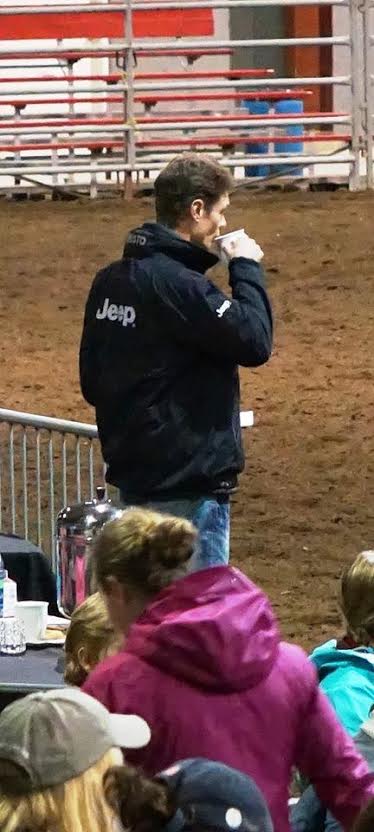For jumping, we switched gears from dressage. Dressage day was all about precision. Jumping, and specifically cross country, is more about adapting to any problems that come up. Jumping tests the horse’s reactions and the rider’s reactions to the situations which arise. It’s not always going to be right. William reminded us that we don’t learn as much if things are perfect the whole time while schooling.
Day two position was as key as day one. Cross country stirrups should be short enough. Lower leg when you are out of the saddle shouldn’t involve too much with your knee. Galloping with shorter stirrups helps keep the correct position in between cross country fences, then sit up just at the fences. We need to keep the body slow on take off. Getting ahead of the horse with our bodies on take off was a big no-no, as we have all heard endless times — bears repeating, as so many riders continue to give it a try!
As warm up for jumping, the focus was on the canter, as we jump courses out of the canter — forward and back, as well as transitions to trot and walk. He is a humble person considering his accolades and success. He shared stories about his experiences that were “hiccups and whoopsies.”
Once such anecdote involved warm up at Rolex on a normally strong horse who was soft and lovely in the warm up for some reason. As it turns out, he went out on course and it all went wrong, as the horse was charging around and not listening, resulting in him pulling up and retiring. It’s a reminder that even the best run into trouble by not following the plan.
Despite the focus on getting a good canter and obedient horse in the warm up, William starts jumping in trot. The horse must look for the jump, and we must encourage them to look at the jumps. He feels starting in trot helps achieve this.
He also doesn’t always school big fences with his horses or students; he prefers to make the exercises more difficult. Training horses and riders with smaller jumps initially promotes relaxation. Then when the fences do go up, the horses and riders don’t panic.
In addition to that, jumping jumps in trot makes horses stay in the air longer, so then the horses need to think more about where their legs are for a longer period of time. It often improves their technique. He commented that trotting fences often makes riders feel like they can’t ride. But never mind, he said, as it’s good for riders to do things that they feel a bit awkward with, rather than doing things that make us feel perfect and great the whole time.
We need to practice what to do when things aren’t exactly “right” when jumping so that during competition we can react quickly and stay in the game. He also had the riders jump a jump at the walk for the same reasons, but the effect is more accentuated. He used several skinny fences for accuracy. In fact, we started off jumping over a narrow box as our first jump! He wants the horses to have to stay on the line that we put them on as a result of getting them to look at the jumps.
If a horse stops at a fence, we must not let them turn away. Back up until you have room to come again. He is absolutely not concerned or focused on getting a perfect distance. He wants the horse to play a part in where it leaves the ground. It’s the rider’s job to produce a good canter and line, and then if it goes wrong, react accordingly. Event riders must learn to adapt to whatever happens.
Our job is to prepare the line and canter, then ride forward to the jump. Riding forward to the jump is NOT accelerating to the jump. There is a difference. When riders got to a longer or shorter distance than ideal, his emphasis was on the rider staying in the moment and conveying confidence to the horse.
After we had jumped a few jump turn patterns, the Intermediate/Advanced group rode the same pattern with one hand. During the lesson, we rode straight lines and bending lines. He liked that there were a variety of stride numbers for all of the riders between fences. He reminded us that so long as the rhythm is good and the pair is relaxed that the number of strides for each horse wasn’t the most important thing.
For each rider, as he had done the previous day in dressage, he made a relevant correction for each rider. He was again able to easily determine what “thing” would help the rider best for the next round, as well as for the next school and the coming weeks and months. We had the opportunity to ride both cross country jumps and show jumps in our courses.
Participants had come from near and far to observe William in action. We had riders from British Columbia, Alberta and from Washington. Riders drove through treacherous winter conditions in order to have the chance to ride. Riding with William was an incredible opportunity, particularly literally in my backyard. Here in British Columbia, we are thousands of miles from the North American epicenter of our sport.
I learned a great deal from this eventing superstar, both while riding and while auditing. Apart from being incredibly knowledgeable, William was gracious and patient with the seemingly endless photo and autograph seekers. The clinic was a huge success. Thank you again to Scott Hayes for his tireless work turning this clinic from a little idea over wine into a magical reality!
WFPisms while jumping
- “We must give the horse freedom without throwing our body forward.”
- “The distance does not matter. What matters is that you don’t fall forward over their necks or backwards off their a#$@# when you get there.”
- “Well done, give him a pat. You are all being a bit stingy with the patting of your horses, aren’t you?”
- “I wouldn’t recommend repeating that last striding you did there. Might give me nightmares. Sometimes we get lucky once, but we rarely get lucky twice. Prepare a little more.”
- “We don’t have to dominate the event horse every second.”
- “Event horses need to learn to jump facing into crowds and other spooky things. At home, I have my horses jumping into banners on the fence line and other things to get them used to that idea.”
- Before a slightly wild red mare’s round … “Good luck.”
- “Riding forward to the jump is NOT accelerating to the jump. There is a difference.”
- “Whether it’s dressage or jumping, we want it to be easy on the eyes.”
- “Horses fresh in the beginning when jumping isn’t a big deal. Let them be horses to a certain extent. It’s to be expected this time of year.”
- “He doesn’t quite draw you to the fence like we’d like him to.”
- “Most horses are slightly lazy or crazy. We hope to find one that is somewhere in the middle.”
- “Shorten the reins!”
- “That time you had a good balance and a good rhythm. I wasn’t scared watching, so that was nice for me.”
- “When you end up getting to a long distance, that’s fine, but when you consistently ask for a long one, eventually you’re going to be in trouble.”























